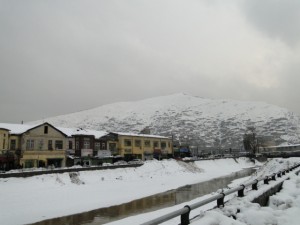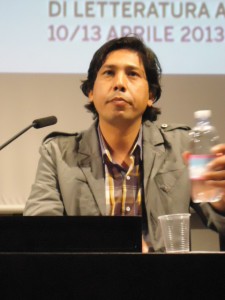A little more than a year ago
I was writing blog posts from Kabul.
One of the most moving experiences of my stay there was when
I visited the Kabul Public Library, which has somehow managed to keep going, despite many adversities.
I was reminded of that visit last week when I went to listen to
Mohammad Hossein Mohammadi, a Hazara Afghan writer. He told the audience that war is not all there is to Afghanistan: despite the many years of conflict there is still such a thing as everyday life – and this is indeed the principal subject of his work.
Mohammad Mohammadi was born in 1975 in Mazar-e-Sharif but he was mainly educated in Iran where his family moved when he was eleven. As a student he went to Balkh, in Afghanistan, to study medicine, but had to return to Iran when the Taliban took power. After the fall of the Taliban he returned again to Afghanistan. He now lives in Kabul where he has founded a publishing house that promotes the work of young writers.
Mohammad strives particularly to write about the everyday world of women in Afghanistan, an endeavour that presents many challenges. Language is not the least of these challenges since Afghan women use a distinctive register of their own. To put some of their words into print, Mohammad explained, can lead to trouble with the censors.
‘In my writing’ said Mohammad, ‘I like the idea of making the reader participate in a continuous process of recreating, with words serving to excite fantasies… I hope my father won’t read my writing. He is a very religious person and he would find it hard to understand my themes.’
Unfortunately only one of Mohammad’s stories has been translated into English. It is called Dasht-e-Leili and it can be read here.
The story’s opening reminded me of Ghassan Kanafani’s unforgettable Rijjaal fi’ ash-Shams (‘Men in the Sun’) but it veered quickly in a different direction. It’s a powerful, vividly tactile piece of writing and it made me eager to read more of Mohammad’s work: I hope there will soon be more translations.
Dasht-e-Leili was translated by Anders Widmark, who is also the author of this excellent essay: ‘The View From Within: An Introduction to New Afghan Literature.’
Widmark writes: ‘What … can be said to epitomize Afghan literature of today, is its high degree of responsiveness and immediacy—in many other literatures a national trauma often demands some sort of “incubation period” before the topic can be processed; in Afghanistan, traumas are attacked by the pen simultaneously as they occur… The immediacy and responsiveness I mention is clearly reflected in both Zalmay Babakohi’s poetic short story “The Idol’s Dust” and in the very physical “Dasht-e Laili” by Mohammad Hossein Mohammadi. Here, two national traumas are dealt with: the Destruction of the Buddhas of Bamiyan in March 2001, and the Dasht-e Laili Massacre in December later the same year.’




